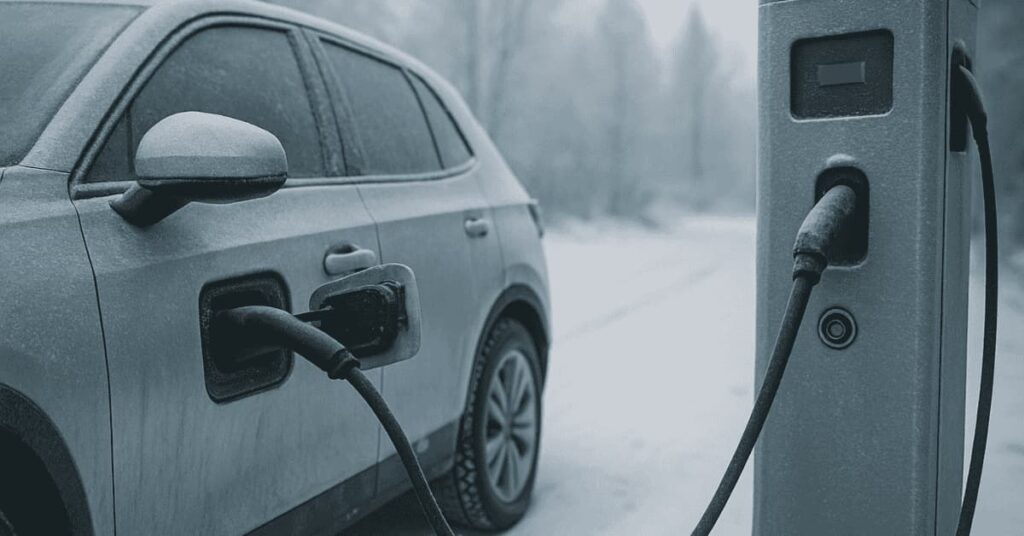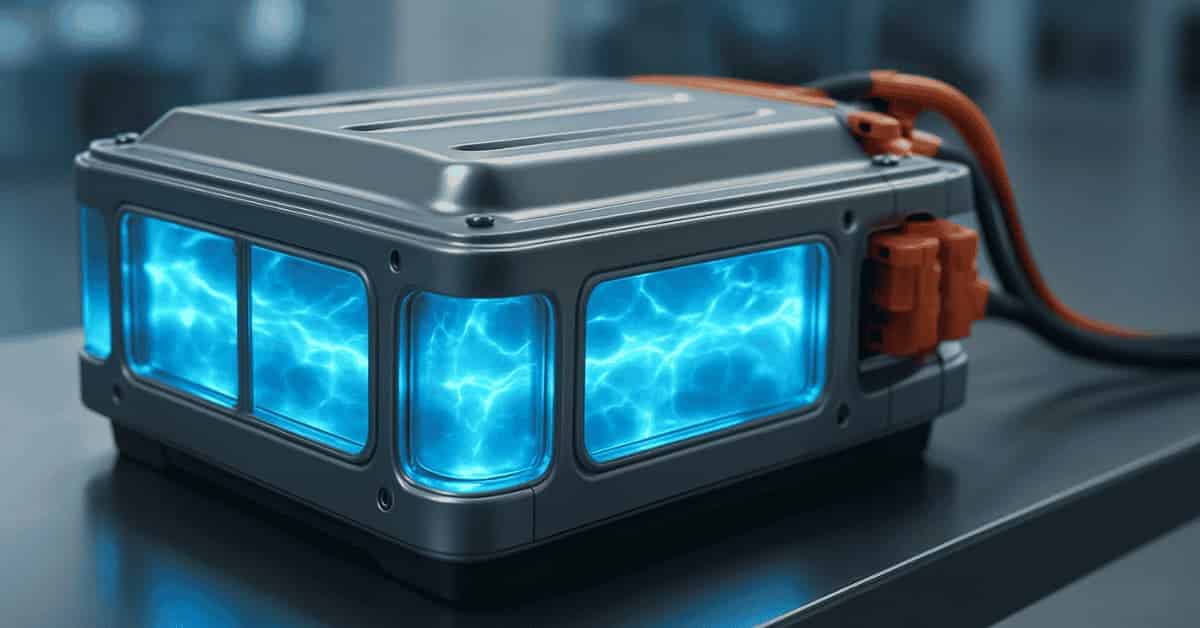EV battery electrolytes are crucial components that allow electric vehicles to function. They are the medium through which charged particles, called lithium ions, move between the battery’s positive (cathode) and negative (anode) terminals. This movement generates electricity when the EV is in use (discharging) and stores energy when it’s charging.
Key functions of electrolytes:
- Ion Transport: They facilitate the flow of lithium ions, which are essential for the electrochemical reactions.
- Performance: They impact battery capacity, charging speed, and how well the battery performs in different temperatures.
- Safety: The electrolyte’s stability helps prevent issues like short circuits and fires.
Most EV batteries use liquid electrolytes, but solid-state electrolytes are an emerging technology promising increased safety and energy density. Ongoing research aims to improve electrolyte properties for longer range and faster charging.
What Are Electrolytes And Why Are They Important?
An electrolyte is a substance characterized by free ions that permit electrical conduction. In lithium-ion batteries, this electrolyte is a liquid that assists the movement of lithium ions between the anode and cathode during charge and discharge operations. This movement is key to your electric vehicle (EV) battery.

Think of a battery like a small city. Think of the anode and cathode as bustling areas. Lithium ions are the people moving between them. The electrolyte is like the roads and highways. It helps people move around. Good, clear roads mean smooth traffic and a thriving city. If the roads are blocked, everything slows down or stops. In the same way, an efficient electrolyte helps ions move quickly. This leads to better battery performance.
Several important performance indicators are affected by the electrolyte’s composition and grade:
1. Charging Speed
A good electrolyte helps ions move quickly. This means faster charging for your EV. Your driving experience is optimized with reduced downtime.
2. Power Delivery
When you speed up, the battery needs to provide a lot of power. A good electrolyte ensures ions move fast enough to meet this need. This gives you quick and strong acceleration.
3. Battery Lifespan
The electrolyte interacts with the anode and cathode. If this interaction is not stable or causes bad reactions, it can damage the battery over time. This reduces the battery’s lifespan and energy capacity.
4. Safety
Some electrolytes can catch fire or react dangerously. Safer electrolytes make the battery system stronger and more reliable.
5. Energy Density
This is very important for how far your EV can go. It plays a role in enhancing the battery’s ability to hold more energy. By using advanced materials, electrolytes can allow batteries to hold more energy, which means more miles on a single charge.
The electrolyte is more than just a simple liquid. It actively participates in the battery’s chemical reactions. It’s a key component that decides how well and safely your EV battery works. Its features directly affect your driving experience, including how fast your car charges and how far it can travel.
Summary: Electrolytes are materials containing mobile ions that facilitate electrical conduction. In EV batteries, they enable lithium-ion movement for charging and discharging, directly impacting charging speed, power delivery, lifespan, safety, and energy density. These components are essential for optimal battery function and improved driving.
The Current Way We Use Batteries: Liquid Electrolytes
Today, most electric car batteries use liquid electrolytes. This technology has been used in portable electronics for many years and now powers electric vehicles (EVs). These liquid electrolytes are usually made of lithium salts, like lithium hexafluorophosphate (LiPF6), mixed in organic liquids such as ethylene carbonate or dimethyl carbonate.
Good Things About Liquid Electrolytes:
- Move Ions Easily: Liquid electrolytes let lithium ions move quickly and freely at normal temperatures. This is important for fast charging and discharging, which helps modern EVs deliver power and charge quickly.
- Well-Known Technology: People have been improving liquid electrolyte systems for decades. Because we know so much about them and how to make them, they are a dependable and affordable choice for large-scale production.
Problems with Liquid Electrolytes and How They Affect EV Range:
Even though liquid electrolytes are widely used, they have limits that affect how far EVs can go, their safety, and how long they last.
1. Catch Fire Easily
Organic liquid electrolytes can easily catch fire. The liquids used often evaporate quickly and can ignite if the battery is damaged or gets too hot. Because of this safety concern, batteries need strong management systems and protective covers. These add weight and size to the battery pack. This extra weight and size can limit how much energy can be safely stored in a given space, reducing the car’s potential range.
2. Dendrite Growth
This is a big problem, especially when trying to make batteries perform better. During the charging of a lithium-ion battery, lithium ions migrate from the cathode to the anode. In liquid electrolyte systems, especially with some anode materials like lithium metal, these ions can stick unevenly to the anode surface. This forms needle-like structures called dendrites. Imagine tiny, sharp fingers growing from the anode. These dendrites can:
a. Poke Through the Separator
The separator acts as a thin partition, ensuring the anode and cathode remain separate. If a dendrite grows long enough to pierce this separator, it creates a direct electrical short circuit inside the battery. This can cause the battery to overheat quickly, leading to a dangerous condition and possibly a fire or explosion.
b. Limit High-Capacity Anodes
Pure lithium metal anodes are not widely used in commercial batteries with liquid electrolytes because of the risk of dendrite growth. Lithium metal anodes can store much more energy than regular graphite anodes. If we could safely use lithium metal anodes, EVs could go much farther. Not being able to use them means we are not using the full potential for energy storage, which limits EV range.
3. Sensitive To Temperature
Liquid electrolytes don’t work well in extreme temperatures. In very cold weather, they conduct ions much less effectively, making the battery perform worse, charge more slowly, and significantly reducing EV range. On the other hand, in very hot weather, liquid electrolytes can break down faster. This makes the battery age more quickly and reduces its lifespan and capacity over time. This means that your EV might not consistently achieve its advertised range in harsh climates.
My talks with many battery engineers confirm that dendrite growth and flammability are constant challenges when making better liquid electrolyte batteries. One engineer told me, “We are always trying to find a balance with liquid electrolytes – making them perform well while keeping them safe. Every time we increase how much energy they can hold, it often creates a higher risk that we have to design around.” This constant balancing act directly affects how much range can be safely given to consumers.
Summary: Liquid electrolytes are standard in EV batteries, offering high ionic conductivity and being a well-established technology. However, they pose safety risks due to flammability and suffer from dendrite formation, which limits the use of high-capacity anodes and reduces EV range. They are also temperature-sensitive, impacting performance in extreme climates. These issues constantly challenge engineers, balancing battery performance with safety and range.
How Electrolytes Boost EV Range
Old liquid electrolytes limit batteries. This has led to a lot of research into better electrolyte systems. The goal is to make batteries that store more energy, charge faster, last longer, and are safer. These new electrolytes help electric vehicles (EVs) go further in several key ways:
1. Allowing Higher Energy Storage
Electrolytes primarily enhance EV range through this mechanism. Current lithium-ion batteries can’t safely use certain materials with liquid electrolytes. For example, lithium metal anodes can store much more energy than graphite. However, they are usually avoided because of a problem called “dendrite formation.” New electrolytes can stop dendrites from forming. This lets us use these high-capacity materials safely. Imagine putting twice the energy into the same battery. This means double the driving range. Electrolytes are essential to use the full power of new electrode materials.
2. Improved Stability And Lifespan
A stable electrolyte does not react badly with the electrodes or break down over time. When electrolytes break down, they create unwanted byproducts. These byproducts use active lithium ions and reduce the battery’s total capacity. This loss of capacity directly lowers your EV’s range over time. New, more stable electrolytes reduce these bad reactions. This ensures the battery keeps its original capacity for much longer. This means your EV will continue to deliver its advertised range for many years. It also reduces the need for expensive battery replacements.
3. Faster Charging
The speed at which lithium ions move through the electrolyte affects charging time. Electrolytes that allow ions to move faster enable quicker charging. This happens without too much heat or damage to the battery. For EV drivers, this means less time at charging stations. It also means more time driving. While it doesn’t directly increase the maximum range, faster charging greatly reduces “range anxiety.” This makes long trips more practical and easier.
4. Enhanced Safety
Safety is very important in EV battery design. Liquid electrolytes can be flammable. Developing electrolytes that are not flammable or are safer removes a big design limit. When engineers don’t need to use as much space and weight for safety features, they can make the battery pack store more energy. It facilitates the inclusion of more active substances in a given area. This indirectly boosts the vehicle’s range. It also gives the driver more peace of mind.
In short, finding better electrolytes is about improving every part of battery performance. Each improvement, whether in energy storage, stability, charging speed, or safety, makes electric vehicles better and more appealing. Such advancements are expected to render range anxiety obsolete.
New Battery Tech: Electrolytes Leading the Way
Batteries with liquid parts have limits. This has led to a worldwide effort to create new battery types. Electrolytes are key to this effort. The most frequently discussed new technology is solid-state batteries. But other technologies are also pushing the limits of what’s possible.
Solid-State Electrolytes: A Big Change
Imagine a battery that does not use flammable liquid but a solid material. This is what solid-state batteries (SSBs) are all about. These solid materials can be ceramics, polymers, or sulfides. They could truly change the game for electric vehicles.
Benefits for EV Range and More:
- More Energy: SSBs provide superior energy density, allowing more power in a reduced size and weight. They don’t use liquid and can safely use lithium metal. Some experts think they could double an EV’s range. For example, a car that goes 300 miles could go 600 miles on one charge, greatly reducing range anxiety for drivers.
- Safer: These batteries are much safer because they don’t contain flammable liquids, lowering the fire risk. Their safety also allows for simpler battery designs, which could lead to lighter vehicles and even more range.
- Last Longer: Solid electrolytes are more stable and break down less than liquid ones. Consequently, the batteries can undergo a greater number of charge and discharge cycles. Your EV battery could last for the entire life of your car or even longer.
- Works in All Temperatures: SSBs should work better in very hot and cold weather. This will reduce how much the EV range drops in harsh climates.
Current Status and Problems:
Solid-state batteries offer many benefits. However, they are still mostly in the research phase. We expect them to be ready for sale later this decade. Here are the main challenges:
- Making Ions Move Fast: Solid materials usually don’t let ions move as fast as liquids at room temperature, making it harder for ions to move quickly. Researchers are creating new materials to fix this.
- Making Them in Large Numbers: It is hard and costly to make solid-state electrolytes and put them into battery cells on a large scale. We need new ways to make them.
- Connection Problems: Establishing robust connections between the solid electrolyte and electrodes proves challenging. But good contact is key for ions to move well.
Stanford’s New Research
Stanford University is doing exciting work in this area. Researchers like Dr. Yi Cui and Dr. Zhenan Bao are leading the way. They are finding new electrolyte solutions. Their work on a new lithium-based electrolyte, called FDMB, shows how much potential advanced electrolytes have.
Dr. Cui is a visionary in materials science. He and his team developed the FDMB electrolyte, which was very stable and performed well. Batteries using FDMB kept an amazing 90% of their charge after 420 cycles. This is a huge improvement over typical lithium metal batteries, which often fail after about 30 cycles. This kind of discovery is needed to make lithium metal batteries work for EVs.
Dr. Yi Cui said, “Our study basically provides a design principle that people can apply to develop better electrolytes.” This means their research helps others create many more new electrolytes.
Dr. Zhenan Bao referred to the electrolyte as the primary vulnerability of lithium metal batteries. This means the electrolyte is the weak spot. It shows how important electrolytes are to making high-energy batteries work. The FDMB electrolyte was also much less flammable than normal electrolytes. This is a big win for safety.
Breakthroughs in solid-state electrolytes are very exciting. The potential for more energy in batteries is huge. This means not just more miles, but a big change in how we power our vehicles safely and efficiently. These improvements are not just ideas. Labs worldwide are testing and improving them. This brings us closer to a future with truly long-range EVs.
Other Promising Battery Technologies
While solid-state batteries get a lot of attention, researchers are also exploring other new battery technologies:
- Lithium-Sulfur (Li-S) Batteries: These batteries use sulfur as a key material in one of their parts (the cathode). They can store a lot of energy. However, they have a problem called the ‘polysulfide shuttle effect.’ This is when certain compounds in the battery dissolve into the liquid part (the electrolyte), causing the battery to lose its ability to hold a charge. To make these batteries practical, we need special electrolytes that can stop this problem.
- Lithium-Air (Li-Air) Batteries: People often call these “breathing batteries” because they use oxygen from the air. They could potentially store as much energy as gasoline. But these batteries are still in the very early stages of research. They face challenges like the electrolyte not being stable when oxygen is present, not lasting long through many charges, and not providing enough power quickly.
These new technologies, though not yet ready for widespread use, show that scientists are always looking for ways to store even more energy. The electrolyte is very important in all these cases and often limits how well the battery works. How far electric vehicles can travel in the future depends on new discoveries in these advanced electrolyte systems.
Comparison of Electrolyte Types
To summarise the key differences and impacts of various electrolyte types on EV range and performance, here’s a comparative table:
| Electrolyte Type | Pros | Cons | Impact on EV Range |
|---|---|---|---|
| Liquid Electrolytes | High ionic conductivity, well-established | Flammable, dendrite formation, temperature sensitive | Good for current range, limits future gains; range reduced in extreme temps |
| Solid Electrolytes | Higher energy density, enhanced safety, longer lifespan, wider temp range | Lower ionic conductivity (improving), manufacturing challenges, interface issues | Potential to double EV range, improved safety allows denser packs, better performance in all climates |
| Gel Electrolytes | Improved safety vs. liquid, better flexibility vs. solid, decent ionic conductivity | Contain some flammable liquid, lower conductivity than pure liquid | Incremental safety gains, moderate impact on range compared to liquid, less than solid |
Source: Compiled from various research and industry reports.
Smart Tips for EV Owners
We’re all excited about new battery tech coming soon. But right now, you can take steps to make your electric vehicle (EV) battery last longer and go further. Think of these as ways to keep your battery healthy.
1. Don’t Charge To Extremes
Try not to always charge your battery to 100% or let it completely drain to 0%. Automakers generally advise keeping your battery’s charge level within the 20% to 80% range for daily use. This puts less strain on the battery cells and makes them last longer.
2. Charge Slowly When You Can
Fast charging is handy, but using DC fast chargers often can create more heat and stress your battery. For daily charging at home, using a Level 1 or Level 2 charger is usually gentler on the battery and helps it last longer.
3. Avoid Very Hot or Cold
Batteries work best in mild temperatures. To protect your EV, park it in the shade during hot weather and in a garage when temperatures drop below freezing. This helps protect the battery. Many EVs have smart systems to control temperature, but avoiding extreme heat or cold is always good.

4. Warm Up Your Battery
If your EV can warm up or cool down its battery before you drive or charge, use this feature! It adjusts the battery to the ideal temperature for performance. This can make your car more efficient and increase its range, especially in cold weather.
5. Drive Smoothly
Driving aggressively (speeding up and braking hard) stresses the battery more and uses energy faster. Smooth, steady driving can greatly improve how far your car can go.
6. Reduce Extra Weight
Just like with a gas car, carrying too much weight lowers efficiency. Remove any unneeded items from your vehicle’s trunk or interior. This lightens the load and helps you get more miles.
7. Keep Tires Properly Inflated
Correctly inflated tires reduce resistance when driving. Your battery doesn’t have to work as hard to move the car. Check your tire pressure regularly.
Stay Updated
Battery technology is changing quickly. Follow reliable news about new battery improvements, your car’s software updates, and EV care tips. Understanding your car’s specific battery type and what the manufacturer recommends is smart.
By following these simple tips, your current EV battery will work its best. This will give you the best range and make it last longer until new battery types arrive.
Summary: To maximise your EV battery’s life and range, manage charging between 20-80%, prefer slow charging, avoid extreme temperatures, drive smoothly, reduce vehicle weight, maintain proper tire pressure, and stay informed about battery tech and your car’s specific needs.
The Road Ahead: A Sustainable Future
Better battery technology isn’t just for individual cars. It’s a big step toward a sustainable future for everyone. Electric vehicles (EVs) use these batteries. They help us use less fossil fuels and fight climate change.
As batteries store more energy, EVs will need fewer raw materials for each mile they travel. Their longer life means we won’t have to replace and recycle them as often. Also, developing safer, non-flammable electrolytes makes battery recycling easier. It also lowers environmental risks from making and getting rid of batteries.
New battery chemistry, especially with electrolytes, is helping more people around the world buy EVs. It’s making electric cars easier to get, more useful, and more attractive to many. We are heading towards a future where clean transportation is common. This is happening because of the quiet but powerful movement of tiny ions in advanced electrolytes.
Conclusion
We’ve explored electrolytes. They form a critical part of your EV’s power source. Electrolytes help ions move. They directly affect how far your EV can go, its safety, and how long its battery lasts. Clearly, electrolytes are key to EV performance.
Today, we use liquid electrolytes, but the future looks bright with solid-state and other new chemistries. This progress shows human cleverness and scientific effort. Scientists and engineers are working hard. They are solving problems and improving electric vehicles. These new ideas will mean longer driving ranges, faster charging, better safety, and more durable EV batteries.
As an expert, I’ve seen this technology grow fast, and I’m truly excited about what’s next. Electrolytes are more than just the battery’s “bloodstream.” They are now powering new ideas. They are moving us toward a future where electric vehicles are better, more convenient, and more sustainable. The journey continues, but with these advancements, it promises to be longer, brighter, and more electric.
FAQs
What does an electrolyte do in an EV battery?
An electrolyte helps lithium ions move. When you charge or discharge a battery, these ions travel between its positive and negative parts. The electrolyte completes the battery’s electrical path, allowing it to store and release electricity.
Why are solid-state electrolytes important for EV range?
Solid-state electrolytes can greatly increase a battery’s energy capacity. They replace flammable liquids with solid materials, making it safe to use special lithium metal parts. These parts can potentially double an EV’s range. Solid electrolytes also make batteries safer and last longer.
How do dendrites affect battery performance and safety?
Dendrites are tiny, sharp growths that can form on the battery’s negative part during charging, especially with liquid electrolytes. They make the battery less efficient and can cause short circuits by breaking through a key battery part. Such a situation carries a considerable risk due to the possibility of excessive heat and fires. Also, dendrites limit the types of materials batteries can use for higher energy storage.
Can I put new electrolyte technology in my current EV battery?
No, you cannot. A battery’s design and production heavily rely on its electrolyte. You cannot just replace the electrolyte in a battery you already own. New electrolyte technologies will be built into new battery packs. These new battery packs will then go into new electric vehicles.
What are the main problems when developing new electrolytes?
Scientists face several challenges. They need to make sure ions can move easily through the electrolyte, especially for solid ones. The electrolyte must also stay stable through many charging and discharging cycles. They also need to find ways to make these electrolytes cheaply and in large amounts. Finally, they must manage how the electrolyte and battery parts interact. This prevents damage and ensures ions move well.







